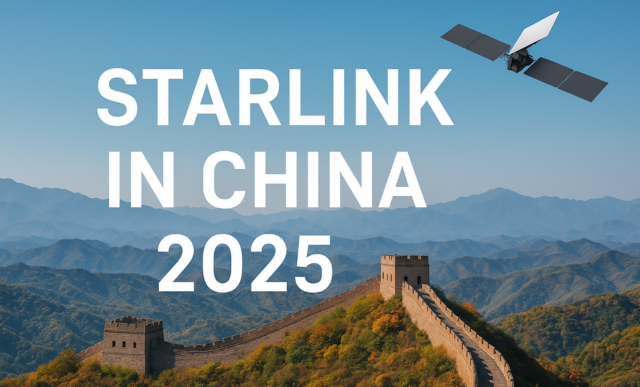Is Starlink Available in China?
The world is moving rapidly toward global internet connectivity. From remote deserts to the middle of the ocean, satellite internet promises to connect people everywhere. One of the most ambitious projects leading this revolution is Starlink, a satellite internet network developed by SpaceX, the aerospace company founded by Elon Musk.
Starlink aims to provide high-speed internet access across the globe, especially in regions where traditional fiber or mobile networks are limited. As of 2025, Starlink has expanded its coverage to more than 80 countries — but many people are still asking: Is Starlink available in China?
This article explores Starlink’s status in China, the reasons behind its unavailability, government policies affecting its operations, possible alternatives, and what the future might hold for satellite internet in the world’s most populous nation.
1. Understanding Starlink: A Brief Overview
Starlink is a satellite-based internet service that uses a network of small satellites orbiting the Earth at low altitudes — known as Low Earth Orbit (LEO). Unlike traditional internet providers that rely on underground cables, Starlink beams internet signals directly from satellites to ground receivers, enabling high-speed connections even in remote areas.
Each satellite communicates with multiple ground stations and user terminals. The result is internet access that rivals broadband speeds, often ranging between 50 Mbps to 250 Mbps, depending on location and congestion.
Starlink’s mission is simple yet powerful: to provide affordable, high-speed internet to everyone on Earth. The system was designed to bridge the global digital divide by connecting rural areas, islands, and regions that have been underserved for decades.
2. Starlink’s Global Expansion
Starlink began its public beta testing phase in late 2020, initially serving users in the United States, Canada, and the United Kingdom. Over the years, the service expanded rapidly across Europe, Asia, South America, Africa, and Oceania.
As of 2025, Starlink is officially available in over 80 countries, including:
-
The United States
-
United Kingdom
-
Australia
-
Japan
-
Germany
-
India (testing phase)
-
Brazil
-
South Africa
-
Mexico
-
Philippines
However, despite this global expansion, China remains a major exception.
3. Is Starlink Available in China in 2025?
The short answer is no — Starlink is not available in China as of 2025.
The Chinese government has not approved Starlink’s operation within its borders. No official license or permission has been granted for SpaceX to provide internet services in mainland China. In fact, Chinese users cannot legally purchase or operate Starlink equipment within the country.
Even though Starlink satellites orbit over China, users there cannot access the network because Starlink requires local ground infrastructure and regulatory approval to function legally.
China maintains strict control over its telecommunications and internet services. All foreign internet providers must comply with government regulations, censorship laws, and cybersecurity policies — which makes it nearly impossible for a privately owned, foreign-operated satellite internet company like SpaceX to operate there freely.
4. Why Is Starlink Not Allowed in China?
Several key reasons explain why Starlink is currently unavailable in China:
a) Government Control of the Internet
China has one of the world’s most regulated internet systems. The government operates a large-scale censorship and surveillance system known as the “Great Firewall of China.” This system restricts access to many international websites and platforms, including Google, YouTube, and Facebook.
Allowing Starlink — a foreign, decentralized, and difficult-to-monitor internet network — could undermine the government’s control over online communications and information flow.
b) National Security Concerns
Starlink’s satellites operate independently from national telecommunications infrastructure, making it challenging for authorities to monitor or control data transmission. For a country that prioritizes cybersecurity and information sovereignty, this is seen as a major national security risk.
c) Local Industry Protection
China has invested heavily in its own satellite internet programs, including GuoWang (国网) — a government-led project that aims to build a Chinese alternative to Starlink. By restricting foreign competitors, China can promote the growth of its domestic aerospace and telecommunications industries.
d) Lack of Regulatory Agreement
SpaceX would need to obtain specific licenses and partnerships with local entities to operate legally in China. So far, no such agreement has been reached, likely due to political, regulatory, and security complexities.
5. China’s Own Satellite Internet Projects
Although Starlink is unavailable in China, the country is not staying behind in the race for satellite internet. China has already launched several Low Earth Orbit (LEO) satellite constellations under its national strategy.
The most notable project is GuoWang, managed by the China Satellite Network Group Co., Ltd., which was established in 2021.
GuoWang aims to launch thousands of satellites into low Earth orbit to provide global broadband coverage similar to Starlink. The system is expected to integrate seamlessly with China’s 5G and future 6G networks, offering high-speed, low-latency internet while maintaining full state control.
Other Chinese companies, such as GalaxySpace and CASC (China Aerospace Science and Technology Corporation), are also working on similar projects. These initiatives show that China intends to become self-reliant in satellite communications rather than relying on foreign technology.
6. Can Chinese Users Access Starlink Through Other Means?
Officially, no.
Using Starlink in China without government authorization is illegal. Importing Starlink equipment such as antennas or routers can result in fines, confiscation, or even criminal penalties.
However, some Chinese citizens living near border regions or overseas territories have reportedly attempted to use Starlink equipment secretly by registering it in neighboring countries like Hong Kong, Mongolia, or Kazakhstan.
While technically possible, such usage is risky and violates Chinese law. Authorities have increased monitoring of illegal satellite communications to prevent unauthorized foreign internet access.
7. Starlink and Hong Kong: A Different Scenario
Hong Kong, being a Special Administrative Region (SAR), operates under a different legal and regulatory system than mainland China. However, even in Hong Kong, Starlink is not officially available as of 2025.
While there were discussions and interest from tech enthusiasts, SpaceX has not yet launched commercial services in the region. This could change in the future, depending on local government policies and partnerships.
8. What About Taiwan and Neighboring Regions?
Interestingly, Taiwan has been more open to advanced satellite technologies. The Taiwanese government is exploring partnerships with satellite providers, including Starlink, to enhance emergency communications and national security resilience.
This demonstrates a stark contrast between China’s restrictive stance and the more open approach of other countries in East Asia.
9. The Future of Starlink in China
So, will Starlink ever be available in China?
At present, it seems unlikely in the short term. The political, regulatory, and strategic differences between SpaceX’s operational model and China’s internet governance system remain too significant.
However, the future may hold possibilities, especially if global cooperation in space technology increases. China might consider limited or cooperative models of satellite internet services — perhaps through joint ventures with local companies, or by allowing controlled access in specific sectors like maritime or aviation.
Still, the more probable path is that China will continue developing its own version of Starlink through GuoWang and other domestic projects, maintaining full control over infrastructure and data management.
10. Alternatives to Starlink in China
For individuals or businesses in China looking for reliable high-speed internet, several alternatives exist:
-
China Telecom, China Mobile, and China Unicom – These are the main telecom providers offering 4G, 5G, and fiber-optic internet across the country.
-
GuoWang (Chinese Satellite Internet) – Expected to launch public services soon, this will provide an official satellite-based internet option.
-
Inmarsat, OneWeb, and SES – While these global satellite operators exist, their services in China are extremely limited and subject to government approval.
11. Global Implications of Starlink’s Absence in China
Starlink’s lack of presence in China has both technological and geopolitical implications.
From a technological standpoint, it highlights the growing digital divide between open and closed internet systems. While Starlink enables uncensored global access in many countries, China continues to maintain a tightly regulated internet ecosystem.
From a geopolitical perspective, the competition between Starlink and China’s GuoWang represents a broader race for space dominance and digital sovereignty. Both systems aim to control global communication networks — a crucial strategic advantage in the 21st century.
12. The Answer
In 2025, Starlink remains unavailable in China due to strict government regulations, national security concerns, and the country’s preference for self-reliance in technology.
While SpaceX continues to expand Starlink across the world, connecting millions of users in rural and remote areas, China is focusing on developing its own state-controlled satellite internet network — ensuring digital independence and data sovereignty.
For now, anyone in China looking to use Starlink must wait for official approval, which may or may not happen in the near future.
However, the growing competition between Elon Musk’s Starlink and China’s GuoWang project may accelerate innovations in global connectivity, potentially reshaping how the entire world accesses the internet in the next decade.

